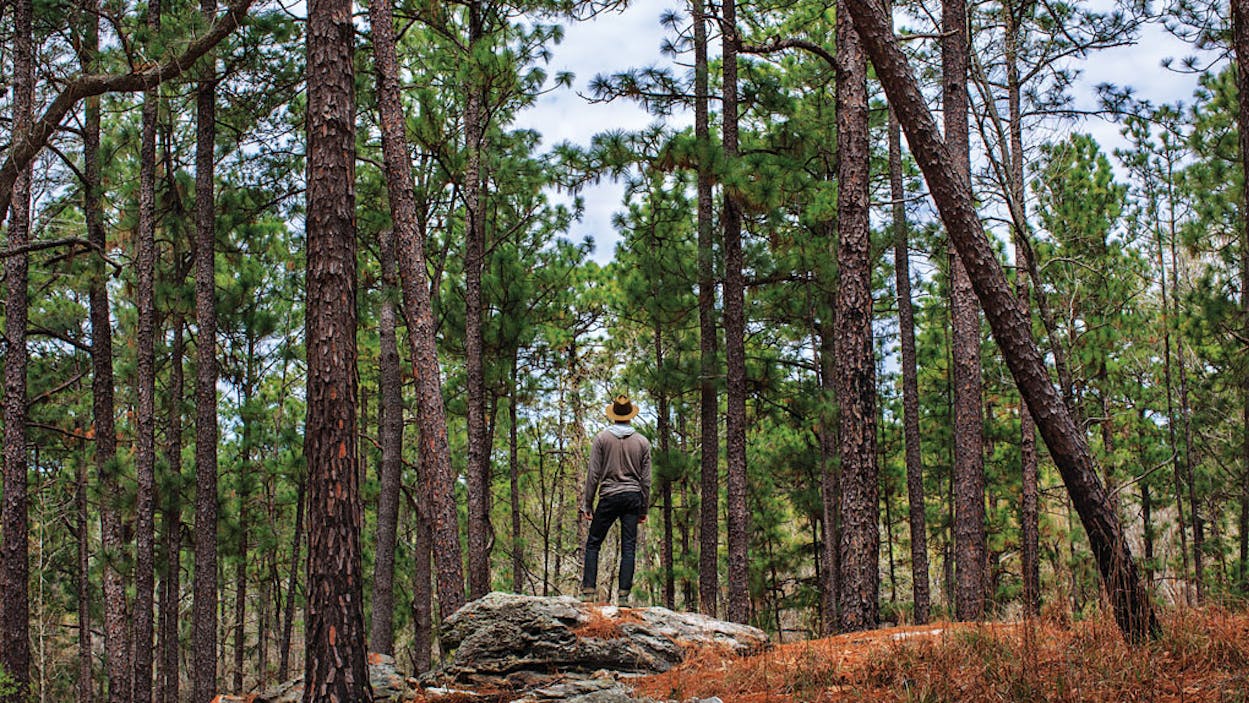Our destination a rustic, isolated but decidedly unthreatening cabin in the woods, a friend and I headed east from Austin for a weekend at La Paz, an aptly named bed-and-breakfast perched on the banks of the Angelina River, a bit northwest of Jasper. As the vexations of the city grew faint in our rearview mirror, we laughed our way through 265 miles of the kinds of roadside diversions that enliven any car trip across Texas—an enthusiastic nut purveyor (“If your wife thinks you’re a geezer take some nuts home that’ll please her”), a dilapidated building just begging for trespassers with the huge, crudely scrawled warning “No Stoping!!!” Soon enough, though, we had passed into the majestic stillness of the Angelina National Forest, where towering conifers eclipsed the sun and the sliver of sky above seemed no wider than the road we were traveling. We had traversed the fabled Pine Curtain.
Culturally Southern and topographically mysterious, the terrain of deep East Texas does not offer the see-for-miles seduction of Big Bend or the pastoral comfort of the Hill Country but instead a tantalizing opacity that both draws you in and keeps you at arm’s length. What’s behind the curtain depends on who’s looking, but for most outsiders, it’s terra incognita, as likely to inspire romantic odes to the natural world as it is fantastical musings on the order of black panthers and Bigfoot.

Speaking of things you’re not likely to find out here, there isn’t much in the way of nightlife or shopping (unless you’re a fancier of pinecone craft). No, this particular swath of East Texas is for nature lovers, for people who feel most at home outside, where the harmony of the woods is interrupted only by the occasional faraway rumble of a truck or putter of a fishing boat. It’s for those who want to lace up and pound, as Frederick Law Olmsted put it, the “untrodden elastic pavement of pine leaves,” something my friend and I hastened to do on a section of the forest’s Sawmill Hiking Trail. Dappled by sunlight and escorted by crystal-clear streams, we followed a meandering path beneath trees that locked arms and stood together in awe-inspiring verticality (and that sometimes “fall silently and without warning,” so says the U.S. Forest Service). Though the trail is marked, it felt just remote enough to generate in us a frisson of Into the Wild anxiety—until we spotted a vivid blue wad of gum affixed to the end of a skinny twig, an irreverent signpost that was both hilarious and reassuring.

This chunk of the state is also for those partial to navigable water, whether the big, blue, bass-filled expanses of Sam Rayburn Reservoir or the quiet tranquility of the Angelina River, a monochromatic ribbon of jade that wends its way among primeval-looking cypress trees dripping with silvery Spanish moss. A kayak trip affords opportunities for flora and fauna galore, including, if you’re lucky, the endangered red-cockaded woodpecker. We didn’t see one but consider ourselves fortunate not to have encountered a cottonmouth or been pooped on by a great blue heron (just YouTube it). We were, however, treated to an appearance by a skittish river otter, quite possibly the cutest critter out here.

An immeasurable rejuvenation of spirit comes from visiting a place whose natural beauty is its main attraction. Returning to La Paz one afternoon, we bypassed the DVD collection and Wi-Fi connection up at the main house in favor of hammocks behind our cabin. Accompanied by glasses of wine and unopened books, our only sound track birdsong and the wind in the trees, we gazed out over the sluggish river, whose glassy surface reflected the sun with sparkles that looked computer-generated. Thankfully they were not. Indeed, our weekend seems best summed up in a message we found in the cabin’s guest book from a thirteen-year-old visitor: “We got some time away from the city, and got to talk to each other without emoticons.”









